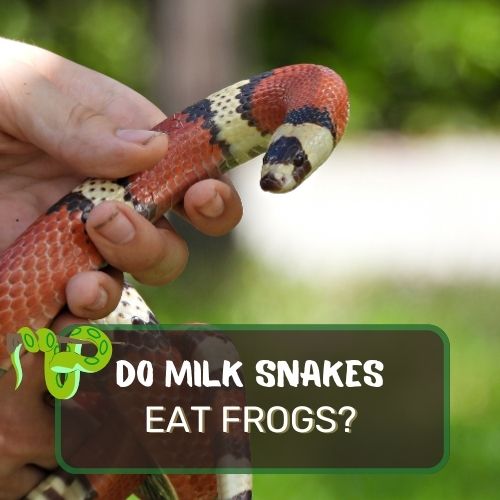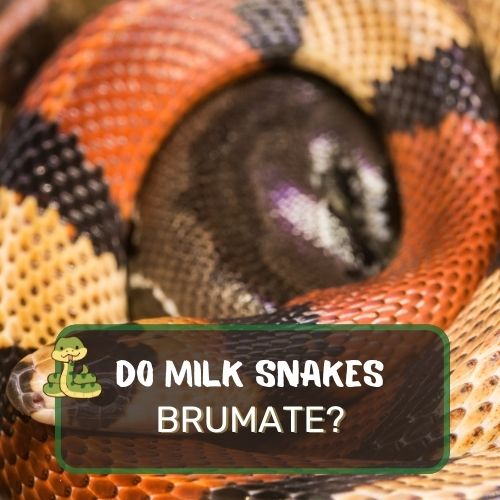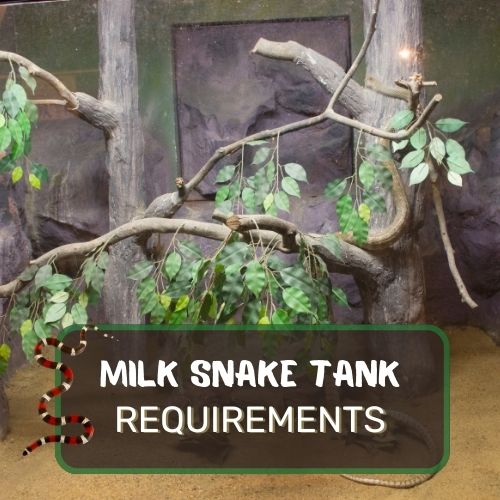Dive into the enigmatic world of milk snakes, a species often misunderstood due to their vibrant appearance.
No, milk snakes do not have fangs. They are non-venomous constrictors. Instead of fangs, they have rows of small, sharp teeth that help them grip and swallow their prey. It’s essential to differentiate them from venomous species, which possess specialized fangs for injecting venom.
In this exploration, we’ll unravel the mysteries behind their dental anatomy, debunk some commonly held misconceptions, and compare them to their venomous counterparts.
From understanding the various types of fangs in snakes to addressing the reasons behind their mistaken identity, get ready for a fascinating journey into the life and times of the milk snake.

Table of Contents
A Dive into the Mouth of the Milk Snake
In this section we will explore the type of teeth that milk snakes have and how it is used in feeding.
What does the inside of a milk snake’s mouth look like?
Picture this: you’re a dentist for reptiles (yes, just go with it!). A milk snake slides into your chair, opens its mouth wide, and gives you a full view of its dental setup. Now, what do you see? You’d notice a row of tiny, sharp, recurved teeth.
These aren’t fangs like you’d see in venomous snakes, but they’re definitely efficient at holding onto prey.
How many teeth do they have?
Milk snakes have several rows of these teeth, both on their upper and lower jaws. The exact number can vary, but it’s these multiple rows that give them a solid grip on their prey.
Once they’ve grabbed hold, it’s pretty challenging for their dinner to make an escape. These teeth aren’t there to chew or grind food like ours. Instead, they’re all about the grab and gulp!
Differences between fangs and other types of teeth.
Now, let’s get technical but in a fun way! Fangs in venomous snakes are modified teeth, designed to inject venom. Think of them like nature’s hypodermic needles.
On the other hand, the teeth of a milk snake are more like tiny hooks, adept at catching and holding onto wriggly prey.
Fangs are specialized. They can be hollow or grooved, allowing venom to flow through. Some snakes have long, movable fangs, while others might have shorter, fixed fangs. And then there are snakes, like our friend the milk snake, that don’t have fangs at all.
Are milk snakes venomous?
Drumroll, please! No, milk snakes are not venomous. But here’s where it gets cool: milk snakes have evolved to look similar to some venomous species, like the coral snake. This mimicry is a fantastic survival tactic.
Predators think twice before messing with them, even though a milk snake is as harmless as they come. Remember the old rhyme, “Red touch yellow, kill a fellow. Red touch black, venom lack.”
It helps differentiate between a venomous coral snake and a harmless milk snake based on their band patterns. But always remember, it’s better to be safe and not handle wild snakes if you’re unsure.

If No Fangs, Then How Do They Eat?
Let’s delve deeper into the culinary habits of these unique serpents.
The fascinating feeding habits of milk snakes.
Milk snakes have a bit of a varied palette. They enjoy dining on everything from rodents and birds to other reptiles, like lizards or even other snakes.
But without fangs, you might wonder how they manage to catch and eat such lively and varied prey. Well, it’s all about strategy and a touch of surprise!
They are constrictors. Meaning, when they spot a tasty morsel, they’ll stealthily approach, and in a quick, fluid motion, they’ll wrap their muscular bodies around their prey. This constriction isn’t about crushing, but rather about exerting enough pressure to immobilize and suffocate.
How they use their jaws and teeth to eat.
Now, onto the fun part! Once their prey has been subdued, it’s time to feast. Milk snakes, like all snakes, have incredibly flexible jaws. These jaws can expand, allowing them to swallow prey much larger than their head.
Those rows of recurved teeth we talked about earlier? They play a pivotal role here. Each tiny tooth acts like a little anchor, ensuring the prey moves in one direction: down the hatch!

Types of Fangs in Snakes
Snakes have evolved an astonishing range of dental hardware to suit their particular needs.
From injecting venom to gripping prey, the variety of fangs can leave you both fascinated and, well, a tad grateful you’re not on their dinner menu. Let’s dissect these dental categories further.
Solenoglyphous (like vipers)
Picture the classic venomous snake fang, and you’re probably thinking of a solenoglyphous tooth. Found in vipers, these fangs are long, hollow, and can fold back when not in use. Think of them as nature’s retractable hypodermic needles.
When a viper strikes, these fangs swing forward, sinking deep into their prey, delivering a potent cocktail of venom straight from their venom glands. It’s fast, efficient, and, for their prey, not the best way to end the day.
Proteroglyphous (like cobras)
Cobras, sea snakes, and their relatives boast the proteroglyphous dentition. Unlike the vipers, these snakes have shorter, fixed fangs located at the front of their upper jaw. While they don’t have the folding mechanism of the vipers, they’re no less efficient.
These fangs have a groove that directs venom from the venom gland into the wound. The next time you see a cobra flaring its hood, remember it’s not just showing off; it’s got the dental arsenal to back up its threat.
Opisthoglyphous (rear-fanged snakes)
This category might sound like the title of a sci-fi movie, but it refers to snakes that have their fangs at the back of their mouths. Boa constrictors and some colubrids fall into this group.
The fangs are grooved, not hollow, and they function by channeling venom into their prey. But here’s the catch: they need to chew a bit to get the venom to flow into the wound. It’s a slower method but hey, whatever works!
Aglyphous (snakes without specialized fangs)
Last but not least, we have the aglyphous crowd. These are snakes without any specialized venom-delivery fangs. Instead, they have a series of small, sharp teeth that aid in catching and holding onto prey.
Our star of the day, the milk snake, falls into this category. No venom, no fancy fangs, just good ol’ fashioned constriction and teeth to get the job done.
There you have it! From foldable fangs to rear-positioned ones, the snake dental world is diverse and brilliantly evolved. One thing’s for sure; these slithering creatures have got their biting game on point!

Comparing Milk Snakes to Other Venomous Snakes
Now, here’s a topic that might raise some eyebrows (and perhaps raise some heart rates!). When we think of snakes, it’s easy to group them into two big categories: those that can hurt us with venom and those that can’t. But, as always, the devil is in the details.
Venomous snakes vs. non-venomous snakes
Venomous snakes, as their name suggests, produce venom, a toxic substance that’s used to immobilize or digest prey and as a defense mechanism. These snakes have evolved specialized fangs to deliver this venom.
On the other side of the spectrum are non-venomous snakes, like our milk snake. They might have teeth, but they lack the venom-producing glands and the specialized fangs to inject it.
Fang configuration in various snake species
Each snake species has its own unique dental blueprint. From the solenoglyphous fangs of vipers to the proteroglyphous ones in cobras, the fang setup varies depending on the snake’s hunting habits and needs.
Milk snakes, being non-venomous, don’t have any of these specialized fangs. Instead, they rely on their agility, constriction abilities, and general teeth to secure their meals.

Reasons Why Milk Snakes Are Mistaken For Venomous Species
In the animal kingdom, looking dangerous can sometimes be as good as being dangerous. And milk snakes have mastered this art.
Their appearance and colors
Milk snakes are colorful, boasting bright bands of red, black, and yellow or white. At first glance, these vibrant colors can signal danger, and that’s not entirely unintentional.
Similarities with other venomous snakes
The crux of the confusion often lies in their striking resemblance to the venomous coral snake. Both have similar band patterns, and it’s this look-alike game that often gives the harmless milk snake its bad rap.
There’s an old saying that goes, “Red touch yellow, kill a fellow. Red touch black, venom lack.” This rhyme helps differentiate the venomous coral snake from the non-venomous milk snake, but it’s always best to err on the side of caution.
When in doubt, it’s best to admire from a distance and let the snake go about its slithery business.
Summary
In your journey through this article, you’ve delved deep into the realm of milk snakes, understanding their dental intricacies and debunking common myths.
Now, equipped with knowledge, you can appreciate these remarkable creatures for what they truly are. Remember, nature thrives on diversity, and each species plays its part. Continue to explore, question, and learn.
Your newfound wisdom is a testament to the wonders awaiting in the natural world. Stay curious!
FAQ
Let’s dive into some frequently asked questions about milk snakes.
What should you do if you get bit by a milk snake?
First off, don’t panic! Milk snakes are non-venomous. If bitten, wash the wound with soap and water, apply an antiseptic, and cover it with a clean bandage. It’s always a good idea to consult a doctor for any animal bite.
How poisonous is a milk snake?
Good news! Milk snakes are not poisonous at all. They lack the venom glands, so there’s no venom to worry about.
Are milk snakes poisonous to dogs?
Just like they’re harmless to humans, milk snakes pose no venomous threat to dogs. However, any snake bite can cause distress or allergic reactions in pets, so always consult with a vet if your dog gets bitten.




0 Comments